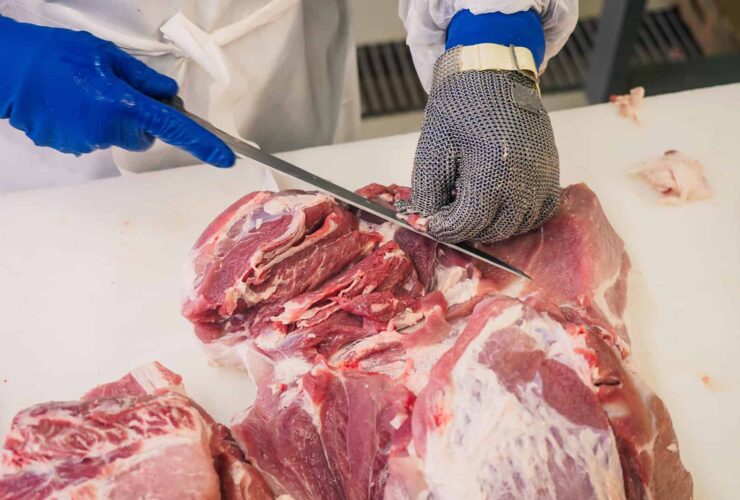There is a high risk for work related injuries in the food processing industry. Reaching across a conveyor, lifting heavy loads, twisting and bending at a work station, performing repetitive tasks, working in awkward positions, operating dangerous equipment – all tasks commonly found in processing plants – are leading risk factors for injury.
According to the California Department of Labor Statistics and Research, the food processing industry has one of the highest lost-workday incidence (LWDI) rates. In 2000, it was almost double than the LWDI rate for all industries as a whole.1
Bruises, cuts, burns, fractures, and amputations are among the top causes of such a high lost-workday incidence rate — due in part to the equipment used in food processing plants.
While those injuries are severe, and drive up the LWDI rate, there is a much more common set of injuries that account for the majority of the high LWDI rate: musculoskeletal disorders.
What are Musculoskeletal Disorders?
Musculoskeletal disorders are caused from the development of damage to muscles, nerves, tendons, ligaments, joints, cartilage, or spinal discs over time. Rarely are they the result of a single event or accident, meaning it can take weeks, months, or even years to develop the symptoms and catch the injuries before they result in lost work. They can result from microtraumas, produce no symptoms or show no findings on medical tests until irreversible damage has occurred, and vary in symptoms from person to person.
Some of the most common symptoms of musculoskeletal disorders include:
- Pain from movement, pressure, or exposure to cold or vibration
- Change in skin color from exposure to cold or vibration
- Numbness or tingling in the legs, arms, hands, or fingers
- Decreased range of motion in the joints
- Decreased grip strength
- Swelling of a joint or part of the arm, hand, finger, or leg
- Fatigue or difficulty in keeping up with performance requirements
While these may seem like minor injuries compared to fractures and amputations, musculoskeletal disorders often lead to an inability to perform one’s job — and result in hefty costs to the employer and employee.
The Underlying Causes
There are a number of physical and environmental factors that, left unchecked, can lead to musculoskeletal disorders. These include:
Physical Factors:
[av_one_third first av_uid=’av-j7tkd’]
- Repetitive motion
- Sustained static posture
- Contact pressure
- Awkward posture
- Forceful exertion
- Vibration
- Lifting
[/av_one_third]
[av_one_third av_uid=’av-4g5jvx’]
- Reaching
- Handling
- Climbing
- Crouching
- Crawling
- Pushing
- Grasping
[/av_one_third]
[av_one_third av_uid=’av-24r5gt’]
- Pulling
- Walking
- Sitting
- Standing
- Kneeling
- Squatting
[/av_one_third]
Environmental Factors:
- Temperature
- Heat
- Illumination
- Ventilation
Preventing Musculoskeletal Disorders
On the plus side, musculoskeletal disorders, and the costs associated with them, are preventable.
Musculoskeletal disorders are caused primarily from repetitive movements that damage muscles, nerves, tendons, ligaments, joints, cartilage, or spinal discs. A small investment in ergonomic equipment, solutions, and training is often enough to prevent injuries, the high costs associated with them, and lower your LWDI rate.
These solutions include equipment such as:
- Manual & Hydraulic Ergonomic Stands
- Smokehouse Cart Lifts
- Platform Lifts
- Ergonomic Stands
- Pallet Lifts
- Adjustable Workstations
- Foot Rails
- Dumpers and Tippers
Ergonomic equipment can position employees and product to avoid awkward posture, over reaching, stretching, crouching, and repetitive motions, to name a few. When compared with the high cost of employee injury, a small investment in ergonomic equipment can save you thousands, if not hundreds of thousands of dollars.
Custom Equipment for Your Application
When you’re ready to invest in and implement ergonomic and safety solutions into your plant, contact the experts at Fusion Tech.
We provide a wide array of ergonomic and safety equipment to prevent employee injuries, including: ergonomic stands, smokehouse cart lifts, platform lifts, pallet lifts, adjustable work stations, foot rails, safety cages and gates, and non-slip application spray. All of our solutions are custom designed and manufactured to fit your specific application needs and durable enough to last for years in a multi-shift operation.
1. Department of Industrial Relations Cal/OSHA Consultation Service Research and Education Unit. Ergonomics in Action: A Guide to Best Practices for the Food-Processing Industry. California: California Department of Industrial Relations, 2003. Print.
[Image via Ged Carroll cc]



